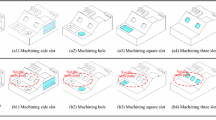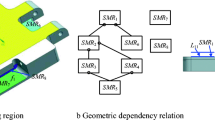Abstract
Model-based definition (MBD) is a new strategy of managing engineering and business processes using 3D models as complete information sources. However, due to lack of feature-based data model representation approach, current MBD models cannot be applied well in manufacturing domain. In this paper, a new multi-level structuralized MBD model based on machining features for manufacturing reuse is presented to capture the abstract information, detailed feature interaction information, and machining semantics information involved. Firstly, the machining features are recognized from an MBD model, which are taken as the machining semantics carrier. Then, the coupled machining feature cluster is introduced to construct the greater granularity’s independent structural element than machining feature, which describes the feature interactions. Finally, the MBD model is structured based on machining features and coupled machining feature clusters in a hierarchical way. In the experiments, some aircraft structural parts are utilized to verify our approach for manufacturing reuse, and the experimental results are analyzed at length to show the application effectiveness of the multi-level structuralized MBD model.
Similar content being viewed by others
References
Hou M, Faddis TN (2006) Automatic tool path generation of a feature-based CAD/CAPP/CAM integrated system. Int J Comput Integr Manuf 19(4):350–358
Quintana V, Rivest L, Pellerin R, Venne F, Kheddouci F (2010) Will model-based definition replace engineering drawings throughout the product lifecycle? A global perspective from aerospace industry. Comput Ind 61(5):497–508
Alemanni M, Destefanis F, Vezzetti E (2011) Model-based definition design in the product lifecycle management scenario. Int J Adv Manuf Technol 52(1–4):1–14
Quintana V, Rivest L, Pellerin R, Kheddouci F (2012) Re-engineering the engineering change management process for a drawing-less environment. Comput Ind 63(1):79–90
ASME Y14.41 (2003) Digital product definition data practices
Xu X, Wang L, Newman ST (2011) Computer-aided process planning—a critical review of recent developments and future trends. Int J Comput Integr Manuf 24(1):1–31
Zhang X, Nassehi A, Newman ST (2014) Feature recognition from CNC part programs for milling operations. Int J Adv Manuf Technol 70(1–4):397–412
Sadaiah M, Yadav DR, Mohanram PV, Radhakrishnan P (2002) A generative computer-aided process planning system for prismatic components. Int J Adv Manuf Technol 20(10):709–719
Joshi S, Chang TC (1988) Graph-based heuristics for recognition of machined features from a 3D solid model. Comput Aided Des 20(2):58–66
Gao S, Shah JJ (1998) Automatic recognition of interacting machining features based on minimal condition subgraph. Comput Aided Des 30(9):727–739
Rahmani K, Arezoo B (2006) Boundary analysis and geometric completion for recognition of intersecting machining features. Comput Aided Des 38(8):845–856
Kim YS, Wang E (2002) Recognition of machining features for cast then machined parts. Comput Aided Des 34(1):71–87
Stage R, Roberts C, Henderson M (1999) Generating resource based flexible form manufacturing features through objective driven clustering. Comput Aided Des 31(2):119–130
Sunil VB, Pande SS (2009) Automatic recognition of machining features using artificial neural networks. Int J Adv Manuf Technol 41(9–10):932–947
Babic B, Nesic N, Miljkovic Z (2008) A review of automated feature recognition with rule-based pattern recognition. Comput Ind 59(4):321–337
Rui H, Shusheng Z, Xiaoliang B (2013) Manufacturability driven interacting machining feature recognition algorithms for 3D CAD models. J Comput-Aided Des Comput Graph 25(7):1089–1098
Mokhtar A, Xu X, Lazcanotegui I (2009) Dealing with feature interactions for prismatic parts in STEP-NC. J Intell Manuf 20(4):431–445
Mokhtar A, Xu X (2011) Machining precedence of 21/2D interacting features in a feature-based data model. J Intell Manuf 22(2):145–161
Dipper T, Xu X, Klemm P (2011) Defining, recognizing and representing feature interaction in a feature-based data model. Robot Comput Integr Manuf 27(1):101–114
Sormaz DN, Khoshnevis B (2000) Modeling of manufacturing feature interactions for automated process planning. J Manuf Syst 19(1):28–45
Liu Z, Wang L (2007) Sequencing of interacting prismatic machining features for process planning. Comput Ind 58(4):292–303
Xu XW (2005) Novel surface and volumetric feature interactions for process planning. Int J Comput Appl Technol 24(4):185–194
Irani SA, Koo HY, Raman S (1995) Feature-based operation sequence generation in CAPP. Int J Prod Res 33(1):17–39
Deja M, Siemiatkowski MS (2013) Feature-based generation of machining process plans for optimized parts manufacture. J Intell Manuf 24(4):831–846
Cordella LP, Foggia P, Sansone C, Vento M (2004) A (sub) graph isomorphism algorithm for matching large graphs. IEEE Trans Pattern Anal Mach Intell 26(10):1367–1372
Tao S, Huang Z, Ma L, Guo S, Wang S (2013) Partial retrieval of CAD models based on local surface region decomposition. Comput Aided Des 45(11):1239–1252
Bai J, Gao S, Tang W, Liu Y, Guo S (2010) Design reuse oriented partial retrieval of CAD models. Comput Aided Des 42(12):1069–1084
Rui H, Shusheng Z, Xiaoliang B, Kaixing Z, Ximao Z (2013) Manufacturing semantics based 3D CAD model retrieval method. Comput Integr Manuf Syst 19(6):1177–1185
Yan X, Yamazaki K, Liu J (2000) Recognition of machining features and feature topologies from NC Programs. Comput Aided Des 32(10):605–616
Rui H, Shusheng Z, Xiaoliang B, Congcong Z, Ximao Z (2014) 3D CAD model retrieval driven rapid NC programming method for NC process reuse. J Mech Eng 50(3):191–198
Author information
Authors and Affiliations
Corresponding author
Rights and permissions
About this article
Cite this article
Huang, R., Zhang, S., Bai, X. et al. Multi-level structuralized model-based definition model based on machining features for manufacturing reuse of mechanical parts. Int J Adv Manuf Technol 75, 1035–1048 (2014). https://doi.org/10.1007/s00170-014-6183-y
Received:
Accepted:
Published:
Issue Date:
DOI: https://doi.org/10.1007/s00170-014-6183-y




